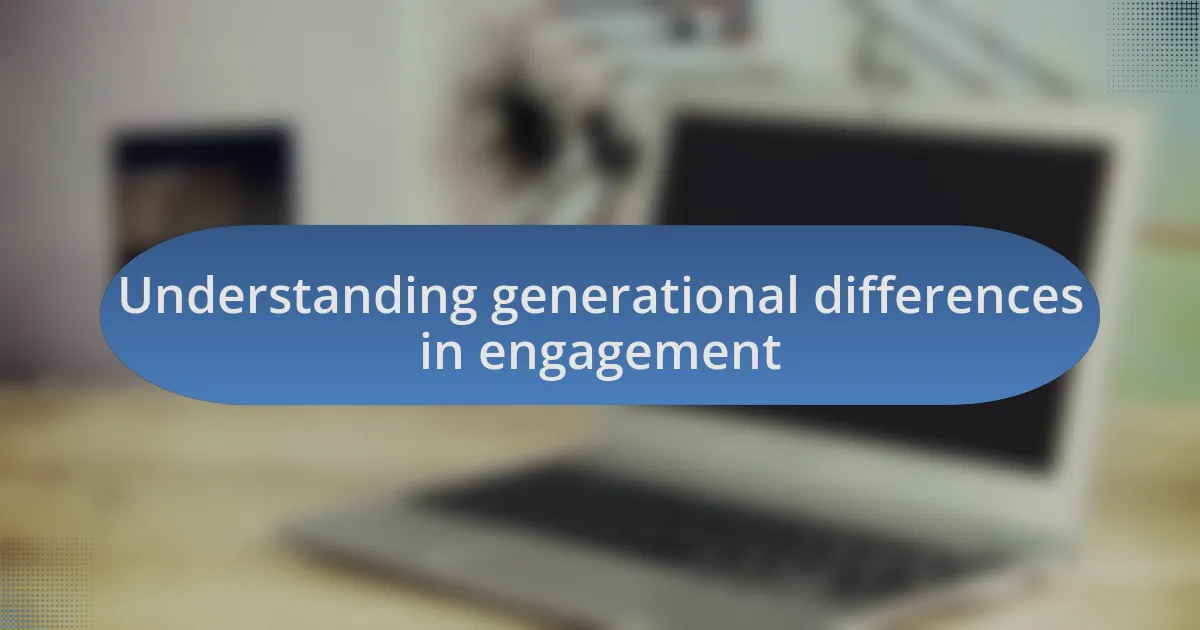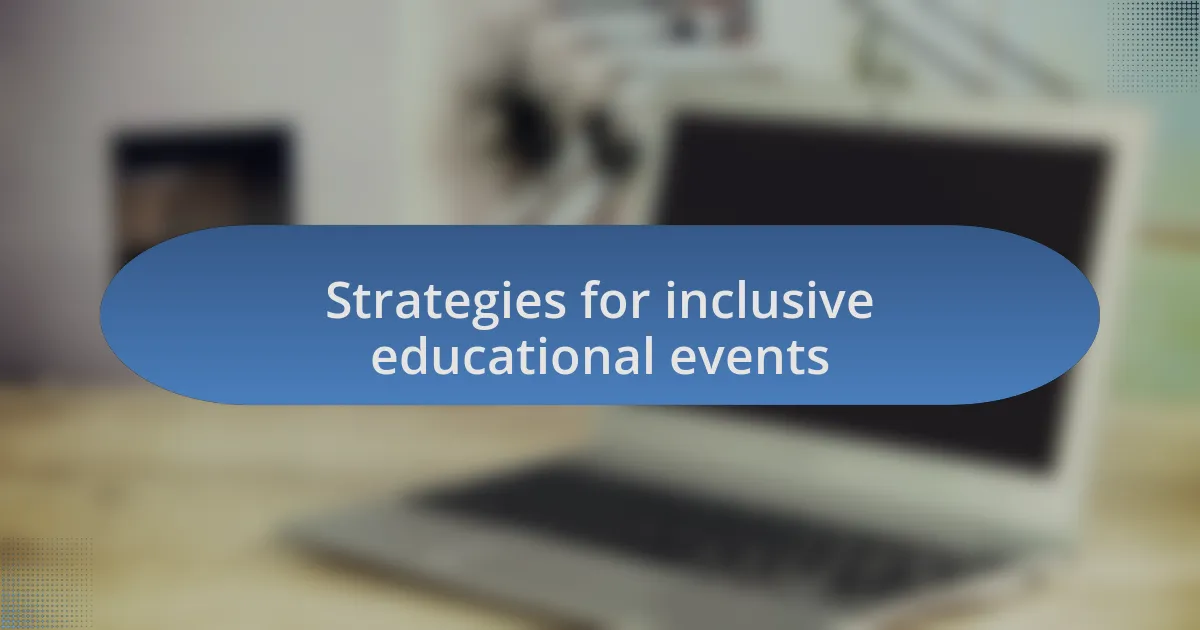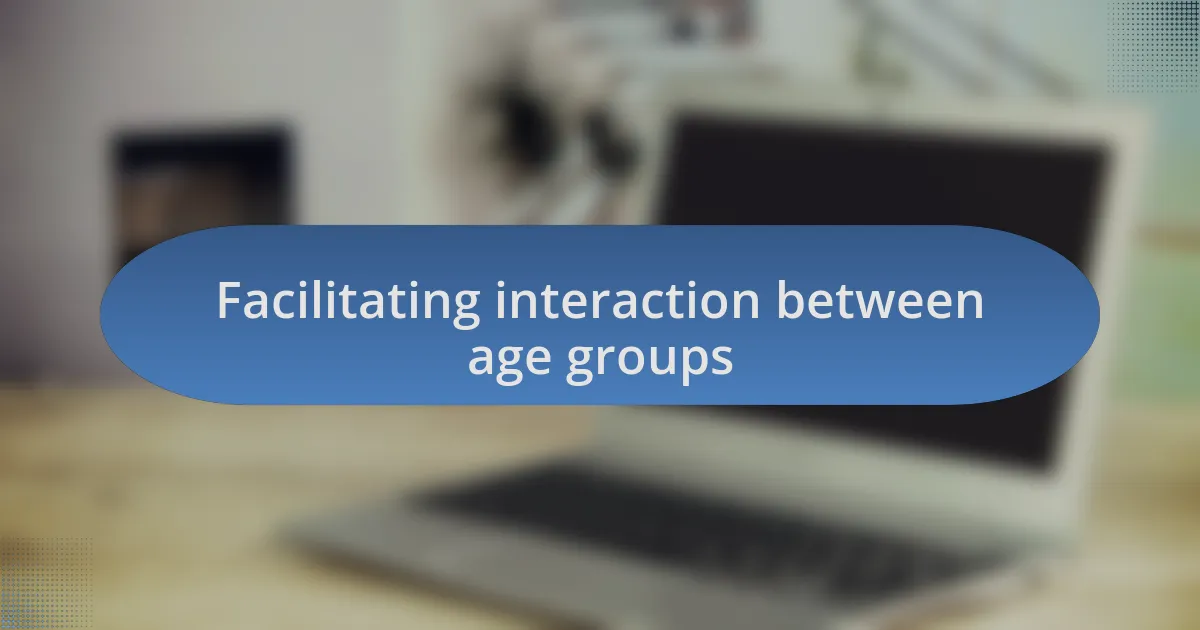Key takeaways:
- Generational engagement styles differ significantly, with Baby Boomers preferring face-to-face interaction and Gen Z favoring digital interactivity.
- Inclusive educational events benefit from a variety of formats and encouraging open dialogue, ensuring all voices are heard.
- Facilitating cross-generational interactions, such as through storytelling and technology, can foster meaningful connections between age groups.
- Measuring success in cross-generational events is best achieved through qualitative feedback and observing participant interactions, highlighting emotional connections over mere content delivery.

Understanding generational differences in engagement
Generational differences in engagement often stem from the varying values and communication styles that define each cohort. For instance, when I participated in a community workshop with both Baby Boomers and Millennials, I noticed how Boomers favored face-to-face interactions while Millennials thrived in digital platforms. This contrast made me realize that understanding these preferences is crucial for creating inclusive educational events.
Consider how Gen Z, having grown up in a tech-saturated world, approaches engagement differently than their predecessors. I recall a virtual seminar where Gen Z participants flourished with polls and quick Q&A sessions, reinforcing how they value interactivity and speed. What if we tailored our approaches to incorporate these dynamics? It prompts me to think about how vital it is to facilitate environments that cater to diverse engagement styles.
Furthermore, the emotional resonance tied to each generation’s experiences influences participation. I once worked with a group of Gen X educators who cherished the opportunity to share their stories, fostering a deep connection with the content. This storytelling aspect made me appreciate how narratives can bridge gaps; they not only engage but also enrich the learning experience across generations.

Strategies for inclusive educational events
When organizing inclusive educational events, I find it essential to blend various formats to cater to different learning preferences. I once facilitated a workshop that included breakout discussions, videos, and hands-on activities, allowing participants to choose how they engaged with the material. This variety not only enriched the experience but also showed me the importance of providing options for everyone to contribute meaningfully.
Creating an environment that encourages open dialogue is another strategy I prioritize. I remember hosting a panel where attendees could submit questions in advance, ensuring that everyone, regardless of their comfort level, could partake in the discussion. This approach emphasizes the idea that every voice matters, bridging the divide between generations and making participants feel valued.
Looking back at my experiences, I realize the power of follow-up. After an event, I initiated a feedback session where participants from different generations shared their thoughts. This step not only enhanced future events but also fostered a sense of community. How can we ensure that everyone feels their feedback is integral? Engaging with participants post-event can genuinely foster connections and improve inclusivity moving forward.

Facilitating interaction between age groups
Facilitating interaction between age groups requires intentional design in event settings. For example, when I organized a community potluck-style discussion, I noticed how the informal atmosphere broke down barriers. Older attendees shared stories that captivated younger participants, and in return, the young ones introduced new ideas and perspectives that sparked lively debates. It was enlightening to observe how food brought everyone to the table, literally and figuratively.
In my experience, incorporating technology can also bridge generational gaps. During one event, I introduced a mobile app where attendees could interact with polls and quizzes in real time. To my surprise, older participants engaged with the technology more than I anticipated, leading to spontaneous collaborations. This moment taught me that embracing new tools can create unique opportunities for dialogue across age groups, raising the question: How can we make technology more accessible and enjoyable for everyone involved?
I have found that using storytelling as a means of connection can be incredibly effective. During a workshop, we dedicated time for participants to share personal experiences related to the topic. I still remember a heartfelt story shared by a retiree, where he discussed how his educational journey shaped his career. The way younger attendees listened intently not only demonstrated respect but also encouraged them to share their own paths. It’s moments like these that remind me of the profound insights that can emerge when we foster an environment of shared learning.

Sharing personal experiences with engagement
One time, I facilitated a workshop where attendees were invited to share their first learning experience. I still remember the surprise on everyone’s faces when a millennial opened up about how a teacher inspired them during their struggles in school. It was a poignant moment that highlighted how, despite differences in age, we all share similar feelings about the power of education, pushing me to wonder: What stories lie buried in each of us that could build connections across generations?
At another educational event, we introduced a ‘Reverse Mentoring’ session, where younger attendees helped older participants navigate social media. The initial apprehension from the older crowd quickly transformed into laughter and enthusiastic exchanges as they discovered new platforms together. It felt empowering to witness how learning from one another can create a vibrant culture of mutual respect, leading me to reflect on how often we overlook the wisdom that exists in a younger generation.
I recall sitting in on a panel discussion where multiple generations shared their views on learning. One older participant’s anecdote about the books that shaped their life made the room resonate with nostalgia, while a high-school student followed with insights from their recent project. This rich tapestry of storytelling not only drew us closer but also fostered a sense of belonging, reminding me that engagement often blooms from the willingness to listen and appreciate our diverse journeys.

Measuring success of cross-generational events
One effective way to measure the success of cross-generational events is through participant feedback. After hosting a collaborative workshop where young and older attendees brainstormed educational resources, I was struck by the depth of the testimonials. People expressed not only their newfound knowledge but also the joy of unexpected friendships formed. Is it possible that the emotional connections made during these interactions hold more value than the content itself?
Attendance numbers and engagement rates are important metrics, but I’ve learned that qualitative insights often reveal the true impact of an event. I remember a mentorship program I organized where younger volunteers coached seniors in tech skills. Post-event surveys showed significant increases in confidence for both groups, and the conversations that started that day continued long after. How can we quantify the relationships formed, and isn’t that what success should really look like?
Additionally, observing interactions during the event can provide a wealth of information. I recall standing in the back of a multigenerational panel, watching as a young woman and a retired teacher engaged in a deep discussion about innovative teaching methods. Their animated gestures and shared laughs spoke volumes about connection. Are these spontaneous moments of engagement perhaps the most telling indicators that we’re fostering understanding across generations?